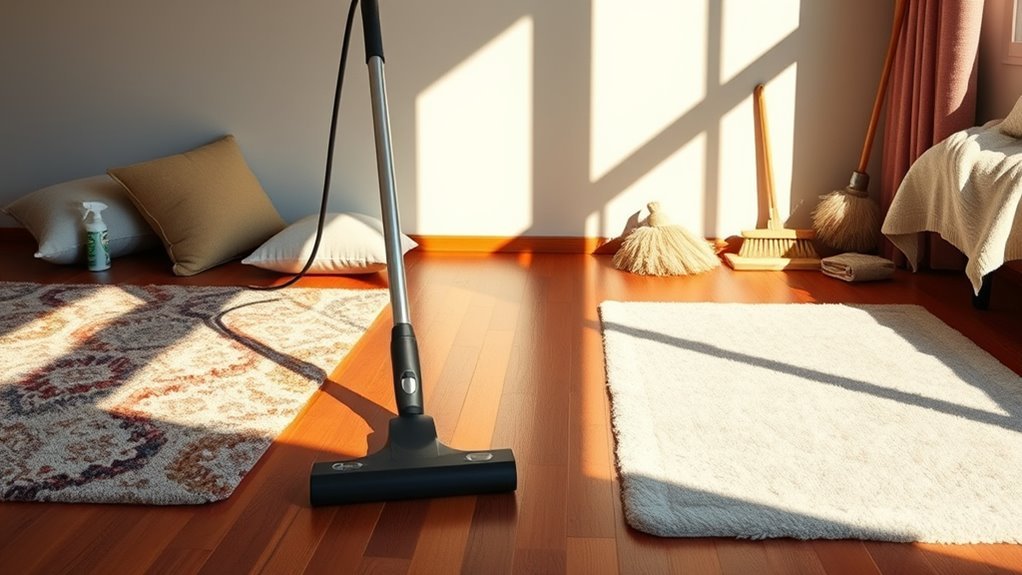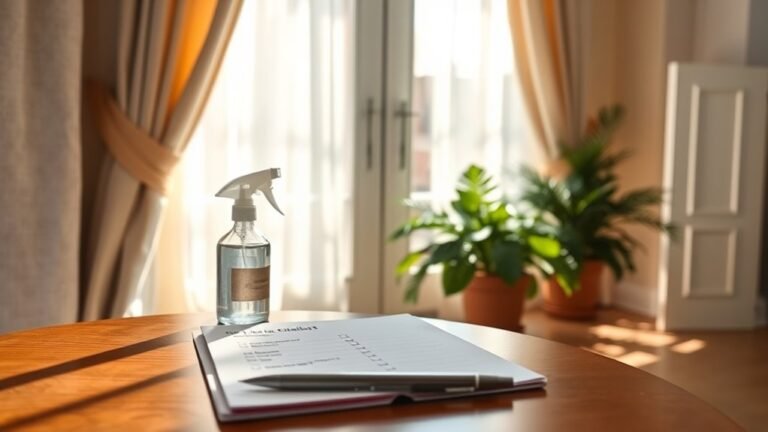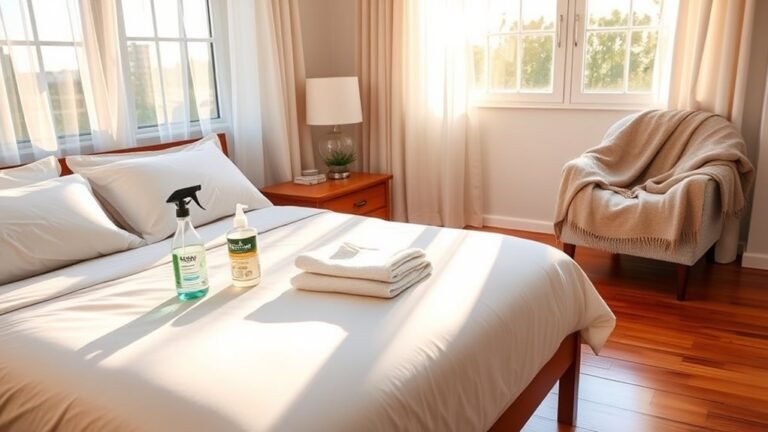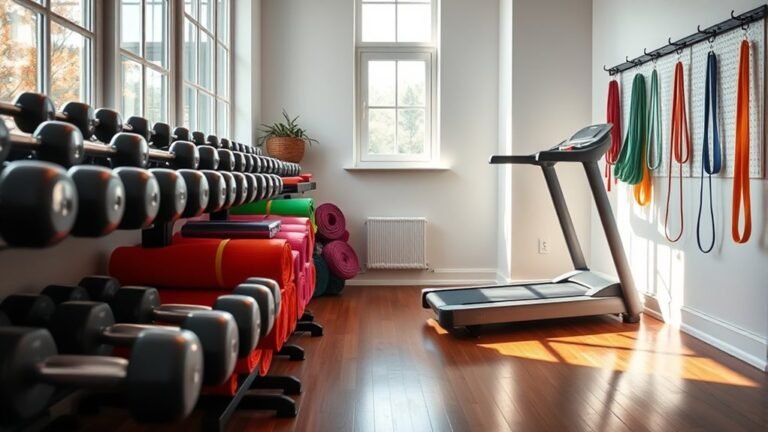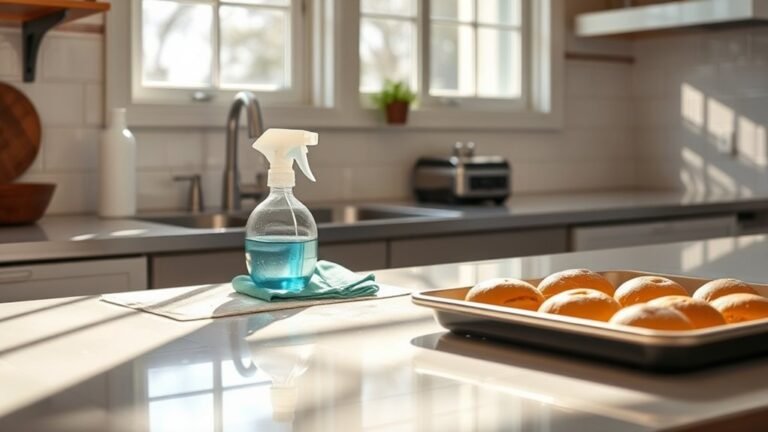How to Clean Bedroom Floors
To clean your bedroom floors effectively, first identify your floor type—hardwood, tile, or carpet—and gather the right supplies like a broom, vacuum, mop, and gentle cleaners. Clear the room by removing furniture and clutter to access every corner. Sweep or vacuum thoroughly, then spot clean any stains using natural solutions like vinegar or baking soda. For hardwood and tile, mop gently; deep clean carpets as needed. Proper drying and regular maintenance keep your floors fresh. Keep going to discover how to maintain that spotless look effortlessly.
Assessing Your Floor Type
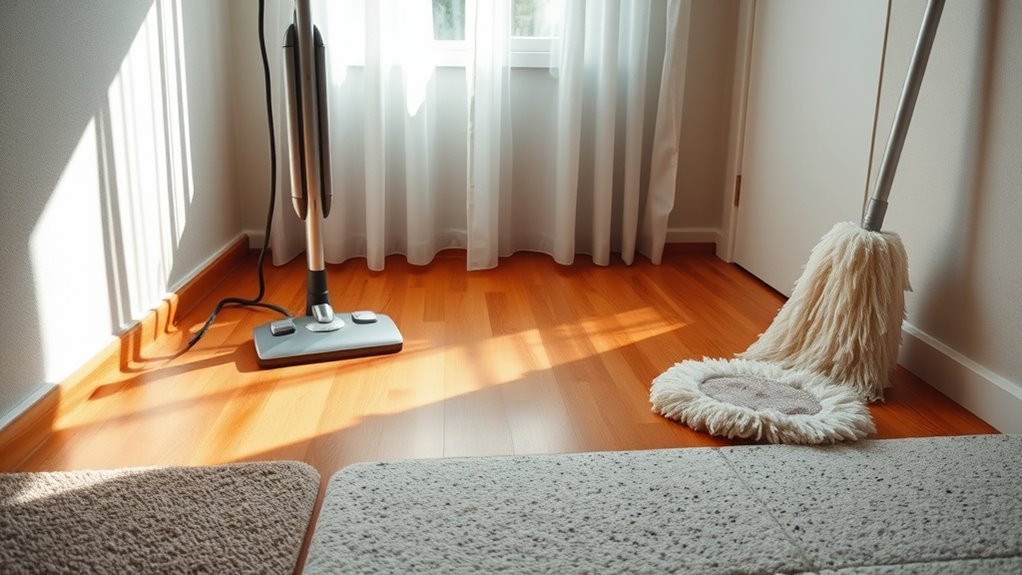
Before you start cleaning, you’ll want to identify the type of flooring in your bedroom. Knowing your floor type gives you the freedom to choose the right cleaning method without risking damage. If you have tile, note its characteristics: smooth or textured surfaces, grout lines, and how it responds to moisture. These details matter because tiles can handle more water but grout needs gentle care. On the other hand, carpet fibers require a different approach. Whether your carpet is plush, looped, or synthetic affects how you clean it and what products you use. Recognizing these distinctions lets you clean effectively, saving time and effort. So, take a moment to assess your floor type before you plunge into it—it’s the key to a cleaner, more carefree space.
Gathering Necessary Cleaning Supplies
Now that you know your floor type, you can gather the right cleaning supplies tailored to it. Freedom in your cleaning routine starts with having the right cleaning tools—whether it’s a soft broom for hardwood, a vacuum suited for carpets, or a mop designed for tile. Don’t forget microfiber cloths for those hard-to-reach corners. To keep things simple and efficient, grab organizing supplies like caddies or bins; these help you keep everything within reach and avoid clutter while working. Choosing the right products and tools not only saves time but also gives you control over your space. By preparing thoughtfully, you set yourself up to clean your bedroom floors with ease and enjoy the freedom of a fresh, inviting room.
Removing Furniture and Clutter
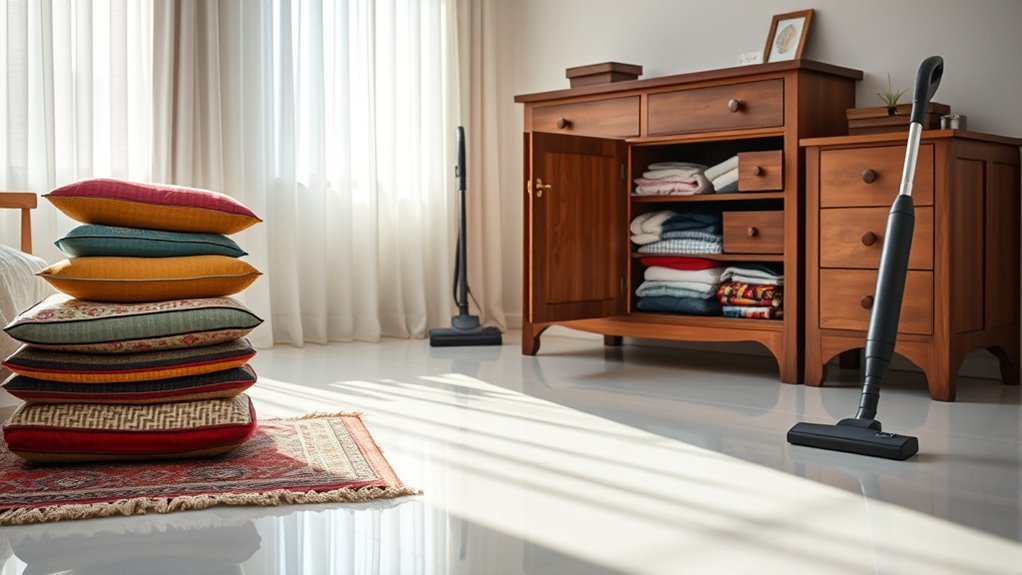
Start by clearing out at least three key areas of your bedroom: under the bed, around the dresser, and near the closet. Removing clutter here frees up space and makes moving furniture easier. Use decluttering tips like sorting items into keep, donate, or toss piles to quickly decide what stays. When shifting furniture, consider a new furniture arrangement that maximizes open floor space and flow. Don’t hesitate to temporarily relocate bulky pieces to another room to access every inch of the floor. This step isn’t just about cleaning; it’s about reclaiming your personal space and feeling unburdened. By thoughtfully removing clutter and rearranging furniture, you create a peaceful environment where your freedom to move and breathe is prioritized.
Sweeping and Vacuuming Thoroughly
Two essential tools you’ll need for cleaning bedroom floors are a broom and a vacuum. Choosing the right tool selection depends on your floor type—hardwood, carpet, or rugs. For hardwood, a soft-bristle broom prevents scratches, while a vacuum with adjustable settings works best on carpets. Technique variations matter: start sweeping or vacuuming from one corner and move systematically toward the exit, ensuring no area is missed. Don’t forget to adjust vacuum height and use attachments for edges and corners. Sweeping loosens debris, making vacuuming more effective. By mastering these techniques and tools, you’ll reclaim your space quickly and enjoy a clean floor without hassle. This thorough approach gives you freedom to move on to the next step confidently.
Spot Cleaning Stains and Spills
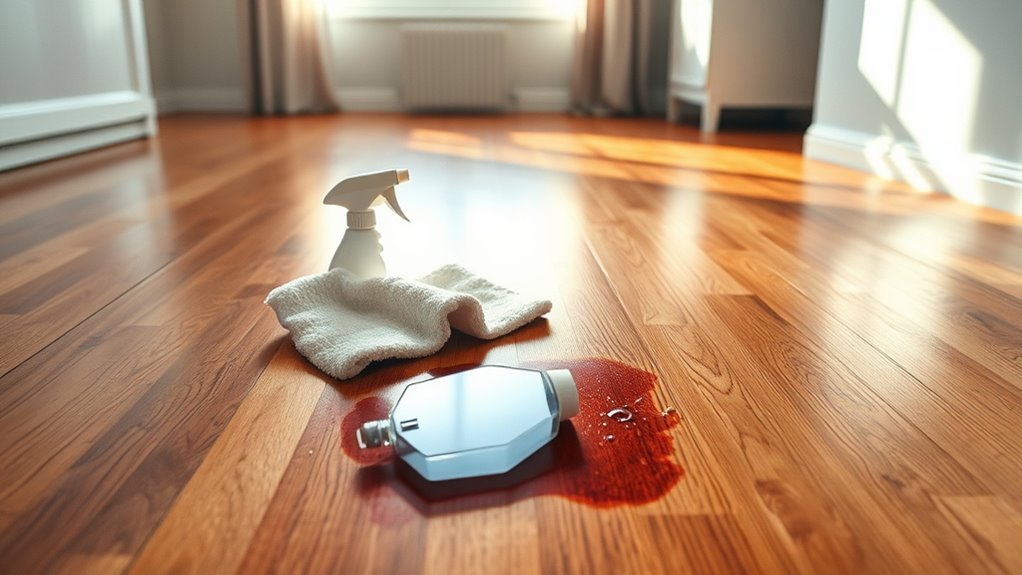
When you spot a stain or spill on your bedroom floor, it helps to know what kind of mess you’re dealing with. Using the right cleaning solution can make all the difference in removing it effectively. Acting quickly will prevent the stain from setting and make cleanup much easier.
Identifying Common Stains
How can you quickly tell what kind of stain you’re dealing with on your bedroom floor? Recognizing the stain type helps you act fast and avoid permanent damage. Blood stains usually look dark red or brown, while ink marks are often vibrant and can seep deep into the fibers. Other common stains include grease spots, dirt smudges, and food spills. Here’s a quick guide to identify them:
| Stain Type | Appearance |
|---|---|
| Blood Stains | Dark red to brown, sticky |
| Ink Marks | Bright, often blue or black |
| Grease Spots | Oily, dark, shiny patches |
| Dirt Smudges | Brown or gray, dusty |
| Food Spills | Varies, often sticky |
Knowing these signs lets you target stains efficiently, giving you the freedom to maintain a spotless floor effortlessly.
Effective Cleaning Solutions
Several effective cleaning solutions can tackle common bedroom floor stains quickly. When you want to keep your space fresh without harsh chemicals, natural cleaners are your best bet. A simple mix of white vinegar and water works wonders on many stains, cutting through grime while being gentle on surfaces. For tougher spots, baking soda sprinkled over the stain and then sprayed with the vinegar solution creates a fizzing action that lifts dirt effortlessly. These eco friendly solutions not only protect your floor but also the environment, giving you the freedom to clean confidently. Remember, always test a small area first to avoid damage. With these options, you can handle spills and stains effectively while sticking to natural, safe products.
Quick Spill Removal Tips
Although spills can happen unexpectedly, acting quickly can prevent stains from setting into your bedroom floors. When you face a mess, quick stain removal is your best friend to keep your space fresh and free. Here are some emergency spill solutions to help you reclaim your floor’s beauty:
- Blot, don’t rub: Gently press a clean cloth on the spill to absorb liquid without spreading it.
- Use mild cleaners: Apply a gentle floor-appropriate cleaner to avoid damage and maintain freedom from harsh chemicals.
- Air dry: Let the spot breathe to avoid moisture buildup and potential damage.
Mopping Hardwood and Tile Floors
When mopping hardwood and tile floors, choosing the right cleaning solution is key to protecting your floor’s finish. You’ll want to use gentle products that won’t damage or dull the surface. Plus, mastering proper mopping techniques guarantees you clean effectively without leaving streaks or excess water behind.
Best Cleaning Solutions
Choosing the right cleaning solution is key to keeping your hardwood and tile floors spotless without causing damage. You want something effective yet gentle, allowing you to enjoy a clean space without the worry of harsh chemicals. Opt for eco-friendly solutions or homemade cleaners to maintain that balance. These options respect both your freedom and the environment.
Consider these top picks for your floors:
- A mix of vinegar and water works wonders on tile, cutting through grime naturally.
- Mild dish soap diluted in water offers a safe, effective cleaner for hardwood.
- Commercial eco-friendly floor cleaners provide convenience without compromising safety.
With these choices, you’re free to keep your floors fresh and your space healthy, all while embracing a cleaner lifestyle.
Proper Mopping Techniques
Now that you’ve picked the right cleaning solution, knowing how to mop your floors properly will make all the difference. When tackling hardwood, opt for a microfiber mop type with a damp—not soaked—head to avoid water damage. Use gentle cleaning techniques, moving the mop along the grain to keep the wood’s natural beauty intact. For tile floors, a sponge or flat mop works best to reach grout lines effectively. You can afford to be a bit more thorough here, but avoid harsh scrubbing that might scratch surfaces. Remember, changing mop water frequently keeps dirt from spreading, and wringing your mop well prevents puddling. Mastering these simple cleaning techniques lets you enjoy spotless bedroom floors without hassle or harm.
Deep Cleaning Carpeted Floors
Since carpeted floors trap dust, dirt, and allergens deep within their fibers, deep cleaning is essential to maintain a healthy and fresh bedroom environment. You want your space to feel open and free, not weighed down by hidden grime. Start by vacuuming thoroughly to remove surface dust. Next, focus on carpet freshening and odor removal by using a baking soda sprinkle or a commercial carpet deodorizer. For a deeper cleanse, steam clean or use a carpet shampooer, targeting stubborn spots and embedded dirt. Remember:
Deep clean carpets to remove dust, odors, and allergens, keeping your bedroom fresh and healthy.
- Treat stains promptly to prevent permanent marks.
- Use eco-friendly products to keep your air pure.
- Rotate cleaning efforts regularly for consistent freshness.
This approach frees your carpet from buildup, helping your bedroom breathe and feel vibrant again.
Drying and Airing Out the Floor
After cleaning your bedroom floors, you’ll want to confirm they dry thoroughly to prevent mold and odors. Start by opening windows and doors to boost air circulation; fresh air speeds up the drying process naturally. If the weather doesn’t cooperate, use fans to keep air moving, focusing them toward damp areas. Proper moisture control is key—avoid leaving wet spots that invite mildew or damage. For hardwood or laminate floors, wipe up excess water immediately and confirm no puddles remain. Remember, good air circulation not only dries floors faster but also keeps your space feeling fresh and free. By taking these simple steps, you maintain a clean, healthy environment while giving yourself the freedom to enjoy your bedroom without worries about lingering dampness or musty smells.
Maintaining Clean Floors Regularly
Although deep cleaning is important, maintaining clean floors regularly is what truly keeps your bedroom looking fresh and inviting. Sticking to a regular cleaning schedule lets you enjoy a clutter-free space without feeling overwhelmed. Here are some essential floor maintenance tips to help you stay on track:
- Sweep or vacuum daily to prevent dirt buildup and protect your floor’s surface.
- Mop weekly with a gentle cleaner suited for your floor type to keep it spotless.
- Address spills immediately to avoid stains and damage.
Frequently Asked Questions
Can I Use Essential Oils When Cleaning Bedroom Floors?
You can definitely use essential oils when cleaning bedroom floors to enjoy their natural benefits. They add a fresh scent and can have antibacterial properties, making your cleaning solutions more effective and enjoyable. Just mix a few drops of your favorite essential oil with water or a gentle cleaner. This way, you maintain freedom from harsh chemicals while keeping your space smelling great and feeling clean. It’s a simple, natural upgrade!
How Often Should I Replace My Vacuum Cleaner Filters?
You should replace your vacuum cleaner filters depending on the filter types and how often you use your vacuum. For HEPA or standard filters, swapping them every 3 to 6 months keeps your vacuum maintenance on point and guarantees maximum suction. If you use your vacuum less often, you might stretch that time a bit. Staying on top of this helps you enjoy cleaner air and freedom from allergies, making your cleaning routine easier and more effective.
Are Robotic Vacuums Safe for All Floor Types?
Think of robotic vacuums as adaptable dancers—they glide differently depending on the floor type compatibility they’re designed for. You’ll find many models with robotic vacuum features like adjustable suction and specialized brushes, making them safe for hardwood, tile, and low-pile carpets. However, some struggle on thick rugs or delicate surfaces, so you’ll want to check specs to guarantee your floors aren’t harmed. This way, you keep your freedom to relax while they do the work.
What Are Eco-Friendly Floor Cleaning Alternatives?
If you want eco-friendly floor cleaning alternatives, you’ll love natural cleaners like a simple vinegar solution. Mixing equal parts water and white vinegar creates a powerful, chemical-free cleaner that’s safe and effective. You don’t have to rely on harsh products, so you can free yourself from toxins and enjoy a fresh, clean space. Plus, these options are budget-friendly and easy to make, giving you freedom to clean your way.
How to Prevent Scratches on Hardwood Floors?
You want to keep your hardwood floors looking their best without the “battle scars,” right? To achieve scratch prevention, start by adding floor protectors under your furniture legs—they act like tiny bodyguards, shielding your floors from unwanted marks. Also, try to move furniture gently and avoid dragging heavy items. By taking these simple steps, you’ll enjoy the freedom of a flawless floor that shines without worry.
